The Art of Blending In: A Practical Guide for Wildlife Photography
For a while, I was quite enthusiastic about recommending military-style clothing for photographing birds and wildlife. However, I’ve realized this isn’t everyone’s cup of tea. Some people dislike the colors, patterns, or even the associations with military wear, and that’s completely understandable. Even hunting gear might be too much for some.
But this isn’t about starting a fashion show in the woods. Instead, I want to share how a bit of common sense and subtle adjustments can help you blend into the forest without overcomplicating things.
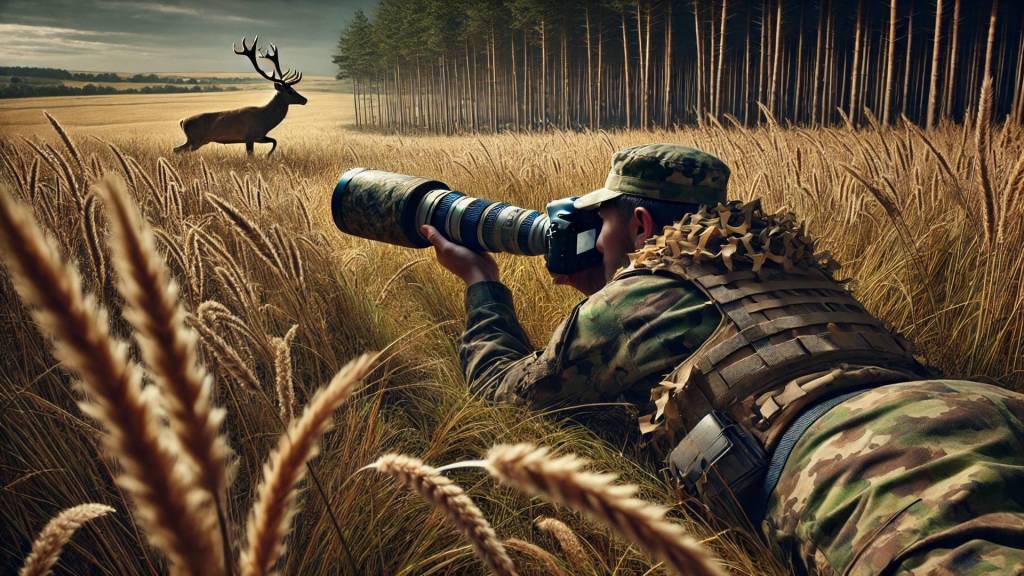
Blending seamlessly with its surroundings, this photographer is military grade camouflaged.
A Lesson from the Field
About three or four years ago, on a February Sunday, I encountered a roe deer about 30 meters away on a forest trail. It was foraging among the bushes. At the time, I wasn’t wearing military camouflage—just dark trousers and a long green coat. I’d parked my bright yellow bike out of sight and moved very slowly until the deer came within “shooting range” of my camera. It was one of my first close-up wildlife photos.
As I stood there photographing, a couple walked by and stopped to ask what I was photographing. By then, the deer had dashed off, so I explained what I’d seen. The man looked at me skeptically and said, “Deer? During the day? We’ve walked this path hundreds of times and never seen anything like that!”
The man was wearing a beige hat, an orange ski jacket, bright blue jeans, and dark red shoes. His partner sported a colorful coat—think Desigual style—and orange boots with daisies printed on . I couldn’t help but think, Well, no wonder you’ve never seen a deer!
Many people don’t consider how much noise they make or how visible they are in the forest. Loud chatter and bright clothing alert wildlife long before you’re close.
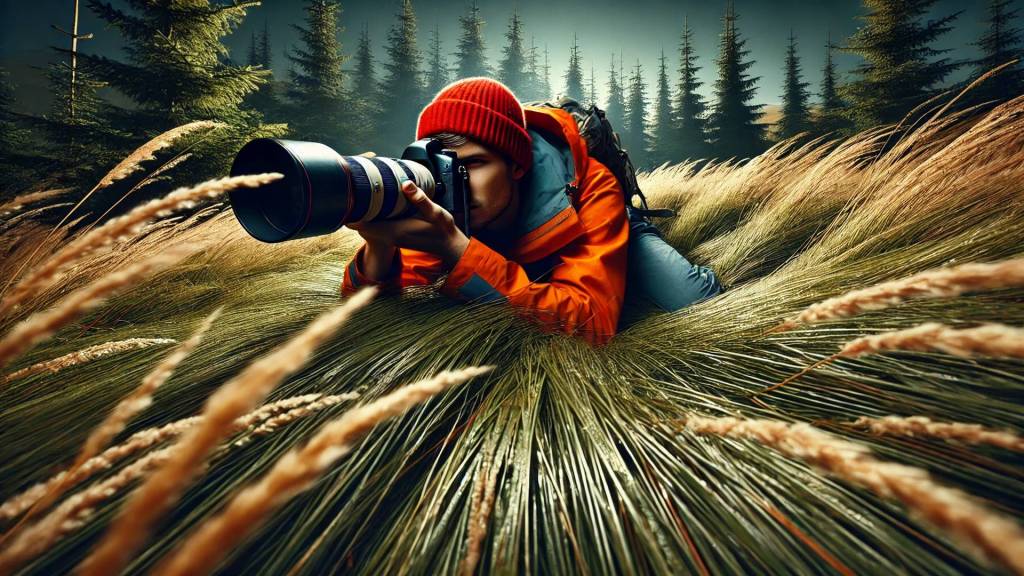
The Opposite of Camouflage
The Basics of Wildlife Photography: Silence and Subtlety
If you want to photograph birds, deer, or other wildlife, the first rule is silence. The second : Break up your form and use earthy colors.
Some argue that you’d need a whole wardrobe to match the seasons, like snow-covered landscapes in winter. But this isn’t a military mission where you must be invisible to an enemy. Instead, it’s about blending in—enough to make animals perceive you as part of the environment rather than a threat.
Wild animals, especially those used to seeing humans, generally don’t mind you being around—as long as you don’t get too close or behave unpredictably. That said, deer, for example, will likely smell you long before they see you.
Even in snowy landscapes, it’s not about wearing pure white from head to toe. Snowy environments still have green pines and brown shrubs. Avoid unnatural colors like blue or orange, which will instantly stand out to wildlife. Use your common sense and adjust your clothing so it complements the surroundings.
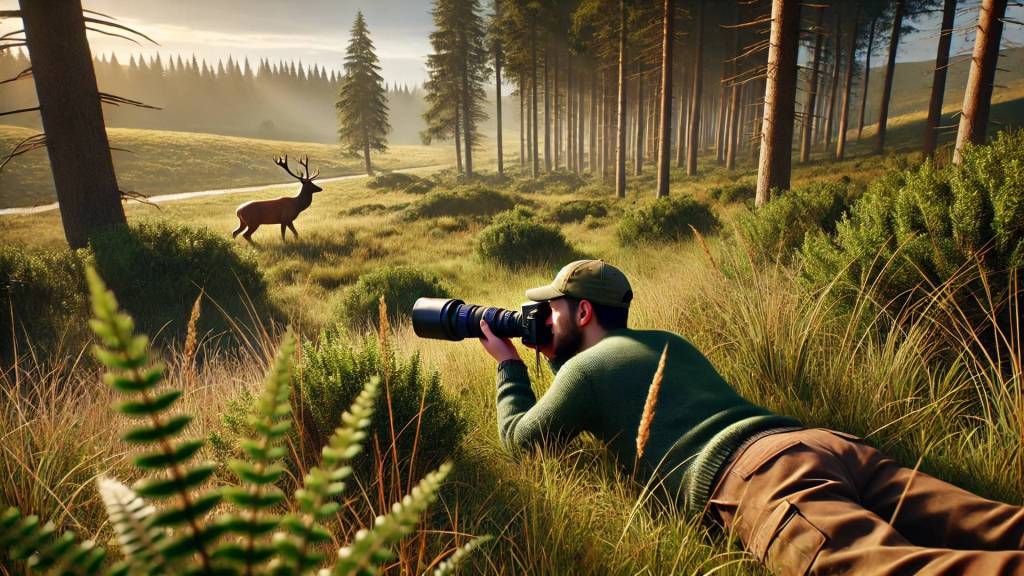
This photographer complements the surroundings using earthy colors
Breaking Up Your Form
Camouflaging isn’t just about colors; it’s also about breaking up your shape. A large black or bright white lens, for example, doesn’t always need a full cover. Adding a few disruptive patterns can make a significant difference. The same goes for people: our tall, broad midsections are recognizable. Break up that shape with earthy colors, and suddenly, you’re more tree-like than human.
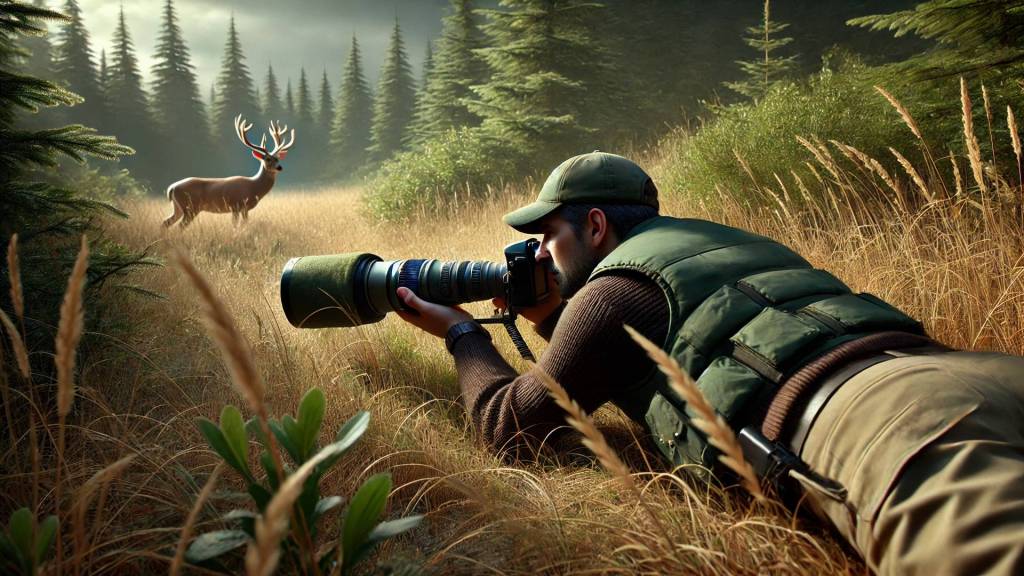
The Perfectly Camouflaged Photographer
Blending seamlessly with nature, the photographer uses earthy tones to stay unnoticed. The lens front is wrapped in camo tape to break up its large, solid shape, while a fishing vest or body warmer helps disguise the body’s outline, separating it from the arms.
An Unforgettable Encounter
About a year ago, I had an extraordinary experience with three roe deer—a buck and two does. The buck stayed at a distance, nibbling on leaves, while the older doe froze, staring in my direction. The younger one, however, was curious. She cautiously approached, pausing occasionally and tilting her head as if trying to figure out what she was seeing – I was wearing a khaki-brown hunting trousers and a jacket with a Belgian camouflage pattern.
By the time she was just five meters away, I could hear my own heartbeat. I didn’t take a single photo in those final moments—she was too close for my telephoto lens, and I was too mesmerized to move. Eventually, the distant sound of an ambulance startled them, and they bolted.
That encounter remains one of the most emotional moments of my photography journey. When a wild animal allows you to get that close, it’s a humbling, unforgettable experience.
However, I strongly advise against doing this with wild boars, moose, or bears. Trust me, you don’t want them getting too close—do you? 😊
So, if you want to photograph wildlife, remember: you don’t need a wardrobe overhaul or a military strategy. Just embrace silence, subtlety, and a little common sense. The rewards might surprise you.
Now that we’ve figured out the best clothing for exploring nature, all we need is a camera, a lens, and maybe a few extra essentials.
What could those be?
That’s a topic for an upcoming blog post—stay tuned!
Extra tips :
My American friend Ted, known for his site https://tpjphoto.net/, gave me a tip : fishing vests ! Of course, I should have realized this sooner, as I often wear a dark brown hunting vest/body warmer in spring. Fishermen wear similar vests, though typically lighter, but they all share one key feature—countless pockets and storage options.
These vests are perfect for photographers. You can simply throw one on over your shirt, sweater, or even jacket. They don’t restrict your movement and break up the outline of your clothing, making them practical and versatile.
For your camera, there’s also a budget-friendly alternative to full lens covers: camouflage tape. But be careful—there are two types!
The good kind: Made of stretchy fabric with just enough adhesive to stay in place. It’s easy to remove, reusable, and won’t damage your gear. This is the one you want!
The wrong kind: It’s like duct tape in camo print. Avoid it at all costs! This type sticks too strongly and is difficult to remove without leaving residue on your lens.
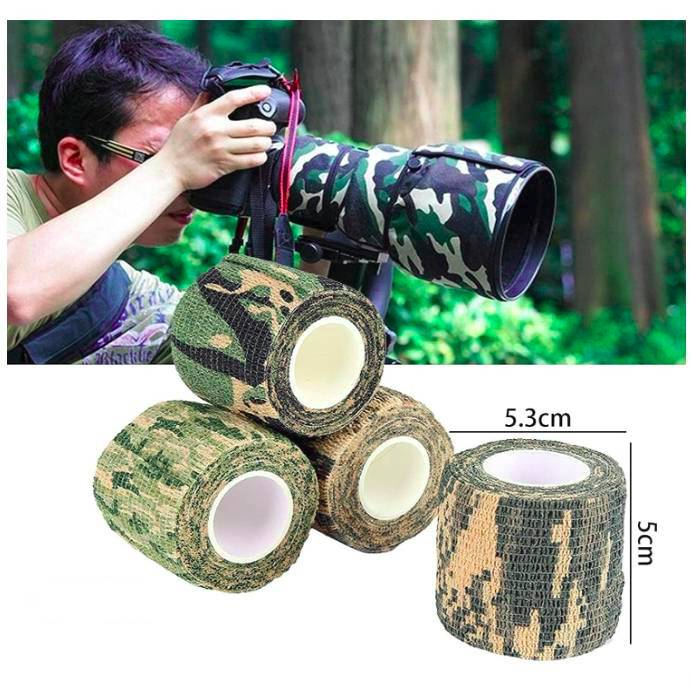
I don’t have any Sponsoring Companies, Patreon support, or Follower Donations.
I don’t drink Coffee, well, I do … but not the financial form you sometimes find on other websites, like ‘buy me a coffee’ 😊
However, what I truly need to keep going is Motivation, and the best part is, it won’t cost you a thing. You can offer it for free – just hit the Like button and Subscribe !
This article was written by Marc R.
While I primarily speak Dutch and have some knowledge of English and a little French, ChatGPT helps ensure my writing is grammatically correct. I often mix Dutch and English in my drafts, and ChatGPT steps in to translate and correct.
Some pictures are created with AI using Dall-E
Discover more from Open Source Photography
Subscribe to get the latest posts sent to your email.




All good tips, for sure Marc. We encounter many walkers along our walks who use the hikes to catch up with their fellow walkers as loudly and as quickly as possible. Once we hear them coming, we know that not even birds or squirrels will stick around, let alone deer. They are surprised to hear what we had already seen, as they see nothing. That being said, we must also walk a fine line. If there is a bear in the area, we are noise makers, frequently calling out Hey Bear and whistling. We don’t mind seeing them from a distance, but have no desire to get up close and personal. We also carry bear spray. In hunting season, we wear orange, so trigger happy hunters do not mistake us for their prey. And on those cold clear crisp winter days, all bets are off, as you can’t stop the snow from squeaking as you walk. Wishing you many more sightings. Allan
LikeLiked by 1 person
Hi Allan,
Thank you so much for your kind words. I completely understand that you can’t apply the same rules on every continent—and that makes perfect sense. Here in Belgium, for example, we don’t have bears, so if I lived in your region, I’d have to adapt my approach as well.
That said, I do hear some familiar complaints, like people making too much noise and not respecting nature. So while habits and ways of interacting with the environment may differ, there’s always some common ground.
Thanks for sharing how things are in your part of the world—it’s great to learn from each other. Take care, Allan, and my very best to you and your family.
Marc
LikeLiked by 1 person
Here, so many people buy into the use of “bear bells” to keep bears aware of humans nearby. I have heard that bells just make bears curious and they will come to investigate. I think there is one joke around that goes something like Question – How can you identify bear scat? Answer – It smells like pepper and has bells in it. 😀
LikeLiked by 1 person
😂😂
LikeLiked by 1 person
Thank you for the ‘fishing vest’ mention. 😁😁. It’s the little things that make photography a bit easier. 😁😁
LikeLiked by 1 person
Don’t mention it, sure thing Ted! you’re absolutely right, but it’s often the little things coming together that truly make a difference. Thanks so much for your support, Ted—have an amazing weekend!
LikeLiked by 1 person
I’ve always worn black or navy blue (most of my life….paired with white shirts in the office, but usually a black shirt and slacks or jeans).
I can also stand remarkably still. I suggest I look like a tree or harmless object, not human.
LikeLiked by 1 person
In some cases, that might just work too! 🙂
Have an amazing weekend, Vicki!
LikeLiked by 1 person